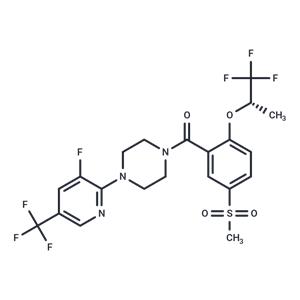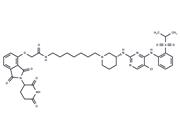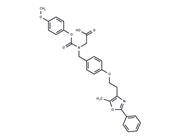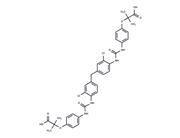| Name | Bitopertin |
| Description | Bitopertin (Paliflutine) (RG1678, RO-4917838) is a potent inhibitor of glycine transporter 1 (GlyT1), with Ki of 8.1 nM for human hGlyT1b and IC50 of 22-25 nM in Chinese hamster ovary cells. |
| Kinase Assay | Association and dissociation kinetic analysis of [3H]ORG24598 to hGlyT1 and ratforebrain membranes is performed. [3H]ORG24598 binding experiments are performed using membranes from CHO cells expressing hGlyT1b and also in membranes from mouse, rat, monkey, and dogforebrains. Saturation isotherms are determined by adding [3H]ORG24598 to rat, mouse, monkey, and dog forebrain membranes (40 μg/well) and cell membranes (10 μg/well) in a total volume of 500 μL for 3 h at room temperature. Saturation binding experiments are analyzed by an Excel-based curve-fitting program using the Michaelis-Menten equation derived from the equation of a bimolecular reaction and the law of mass action:B=(Bmax×[F])/(Kd+[F]), where B is the amount of ligand bound at equilibrium, Bmax the maximum number of binding sites, [F] the concentration of free ligand, and Kd the ligand dissociation constant. For inhibition experiments, membranes are incubated with 3 nM [3H]ORG24598 and 10 concentrations of Bitopertin for 1 h at room temperature. Schild analysis is performed in the presence of increasing concentrations of [3H]ORG24598 (1-300 nM). IC50 values are derived as described above. Ki values are calculated according to the following equation: Ki=IC50/(1+[L]/Kd)[1]. |
| Animal Research | Bitopertin (RG1678) is dissolved in H2O with 0.3% Tween 80 (Mice)[1]. Bitopertin (RG1678) is prepared in Polysorbate 80, HEC, Methyl- and Propylparaben pH 6.0 (Rats)[1].Male NMRI mice (20-30 g) are treated with Bitopertin (0.3, 3, 1, and 10 mg/kg p.o.) or vehicle (p.o.). After 1 min, L-687,414 (50 mg/kg s.c.) or vehicle is given. After 15 min of habituation in the activity chambers, horizontal activity is recorded for 60 min. The time course of Bitopertin effects on L-678,414-induced hyperactivity is also examined; locomotor activity is assessed 2.5, 4.5, and 24 h after administration of Bitopertin (L-678,414 is always given 15 min before the activity procedure). In addition, the effect of subchronic Bitopertin is investigated. Mice receive vehicle or Bitopertin (1 mg/kg p.o.) for 4 consecutive days and L-678,414-induced hyperactivity is evaluated on day 5. Wistar rats receive a 14-day treatment of PCP HC1 (5 mg/kg) or vehicle (NaCl 0.9%, 5 mL/kg i.p.). 24 h following the last injection, rats (6-18 per group) are allowed to individually habituate to the test boxes for 30 min. Rats then received Bitopertin (1, 3, 10 mg/kg p.o.) or vehicle (Polysorbate 80, HEC, Methyl- and Propylparaben pH 6.0; 5 mL/kg p.o.), followed after 1 h by 1 mg/kg D-amphetamine or vehicle i.p. Horizontal activity is recorded directly after the administration of Bitopertin until 120 min after dosing with amphetamine. Data are analyzed by ANOVA supplemented by Fischer's least significant difference post hoc test. |
| In vitro | RG1678 noncompetitively inhibits [3H]glycine uptake in cells stably expressing hGlyT1b and mGlyT1b, with IC50 values of 25 ± 2 nM and 22 ± 5 nM, respectively (n = 6) and competitively displaces [3H]ORG24598 binding with a Ki of 8.1 nM at human hGlyT1b in membranes from Chinese hamster ovary cells. RG1678 has no effect on hGlyT2-mediated [3H]glycine uptake up to 30 μM concentration. There is no significant species difference in the pharmacology for RG1678 based on the ability of the compound to displace [3H]ORG24598. In hippocampal CA1 pyramidal cells, RG1678 enhances NMDA-dependent long-term potentiation (LTP) at 30 nM (213 ± 18%; n=7), 100 nM (269 ± 44%, n=13) but not at 300 nM (152 ± 14%; n = 9)[1]. |
| In vivo | Administration of RG1678 produces a long-lasting (>3h) dose-dependent increase in extracellular glycine levels both in microdialysis experiments conducted in rats and CSF of rats. In mice, RG1678 dose-dependently and significantly attenuates hyperlocomotion induced by the psychostimulant D-amphetamine. RG1678 also prevents the hyper-response to D-amphetamine challenge in rats treated chronically with phencyclidine, an NMDA receptor open-channel blocker[1]. |
| Storage | Powder: -20°C for 3 years | In solvent: -80°C for 1 year | Shipping with blue ice. |
| Solubility Information | DMSO : 50 mg/mL (92 mM)
H2O : Insoluble
Ethanol : 5 mg/mL
|
| Keywords | inhibit | Bitopertin | GlyT | Inhibitor | RO 4917838 | RG-1678 | RG 1678 | Glycine transporters | RO-4917838 |
| Inhibitors Related | Sarcosine | Opiranserin hydrochloride | Iclepertin | ALX-1393 | Amoxapine |
| Related Compound Libraries | Bioactive Compound Library | Anti-Neurodegenerative Disease Compound Library | Neuronal Signaling Compound Library | Drug Repurposing Compound Library | Inhibitor Library | Bioactive Compounds Library Max | Human Metabolite Library |

 United States
United States



